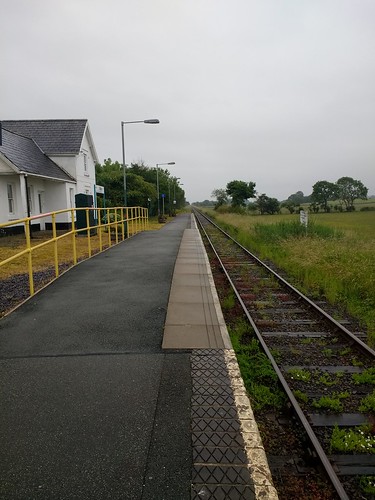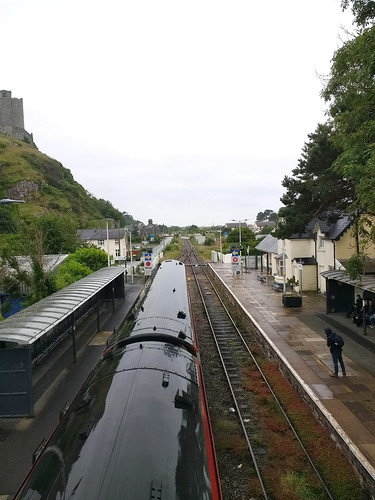I'd initially planned to make my June 2021 journey to Central Wales by train but was shocked to discover that, at that time, Rail Replacement Buses provided the only service between Shrewsbury and Machynlleth, presumably because of emergency Covid-19 timetabling. The remainder of the Cambrian was being operated as an isolated railway with services from Machynlleth to Aberystwyth and Machynlleth to Pwllheli. This was feasible because Machynlleth has a maintenance depot for the Diesel Multiple Units working on the line and a diesel refuelling point.
The Cambrian Line is single with passing loops so is a good illustration of the problems of safely and effectively working a long-distance route where trains in opposite directions must be timetabled to pass where loops are provided. Track Diagrams of the modern Cambrian Line can be found in book reference [1]. Alternately, the Railcam.UK site offers access to simplified track diagram with real-time information on train movements. There's a brief introduction to the Railcam.UK site in my post here.
The Aberystwyth service shares the single line from Machynlleth as far as Dovey Junction where a loop is provided allowing Up and Down services on the Aberystwyth branch to pass when required. Passing loops are provided on the Pwllheli line at Porthmadog, Harlech, Barmouth, and Tywyn. Intrigued, I put together a working timetable of the Monday to Friday service being offered. It's rough and incomplete, I'm afraid, but I hope gives some idea of the service provided.

Cambrian Line 2021: Machynlleth - Aberystwyth Train Times: Mon-Fri June
(Click for larger view)

Cambrian Line 2021: Aberystwyth - Machynlleth Train Times: Mon-Fri June
(Click for larger view)

Cambrian Line 2021: Machynlleth - Pwllheli Train Times & Pwllheli - Machynlleth Train Times (Mon-Fri, June)
(Click for larger view)
The way in which the timetable is arranged to allow up and down trains to pass at loops is, I hope, made clearer by a train graph, shown below. Again, this is rough and incomplete and I haven't corrected errors where trains don't quite meet in the right location but should illustrate the difficulties timetable planners face in constructing single-line timetables. Time is plotted horizontally left to right, starting at midnight. Mileage (in miles and chains) is plotted vertically, based on a reference point at Whitchurch measured via a long-gone railway!

Cambrian Line 2021: Train Graph Machynlleth - Pwllheli (Mon-Fri, June)
(Click for larger view)
All of the stations on the Cambrian Line have been modernised and drastically simplified, are generally unstaffed and many are request stops. To board at a request stop, you have to handsignal the approaching train (like catching a bus). To alight at a request stop, you must inform the conductor on boarding who, in turn, alerts the driver.
When we set off from home by road the weather was benign but, as we travelled further into Wales, the weather deteriorated so most of the time at my destination in the Harlech area suffered either patchy or heavy rain. Study of the temporary railway timetable suggested that it should be possible to board a Pwllheli-Machynlleth service at Talsarnau station, travel 3 miles 30 chains south to Harlech station and almost immediately catch a northbound service to return to Talsarnau. And the plan worked!
Talsarnau, which had a population of 550 in the 2011 census, now has a station featuring a small car park, a single platform (raised in the centre section to facilitate boarding), electronic passenger information system, public address and 'bus shelter'. The original station building is now in private ownership.

Cambrian Line: Talsarnau Station, looking north

Cambrian Line: Talsarnau Station, looking south with the original station building on the left.
The southbound train, a 2-car Class 158 in Transport for Wales livery, arrived just a few minutes late and I was surprised at how full it was. Face coverings were required by law on the train and, to ensure Social Distancing, some seating was marked out of use. Because Wales now has its own Devolved Government, law and guidance differs in some respects from that elsewhere in the United Kingdom. The train made good time on the short journey to Harlech.
Retaining its passing loop and Up and Down platforms linked by an elderly footbridge, Harlech station still hints at its origins. Once again, the station buildings on the Down platform are now in private ownership and unattractive modern shelters are provided for current travellers.

Cambrian Line: Harlech Station in the rain looking south, with southbound Machynlleth train waiting to cross an approaching Pwllheli service. On the left, Harlech Castle looms over the scene.

Cambrian Line: Harlech Station in the rain looking north, with southbound Machynlleth train waiting to cross an approaching Pwllheli service.
The northbound service arrived, another a 2-car Class 158 in Transport for Wales livery and quickly took us back to Talsarnau. Again, the service was well-patronised. There is one intermediate station between Harlech and Talsarnau called Tygwyn but this station was not in use at the time of my visit. The National Rail website explains:-
There are no trains at Tygwyn until further notice. In order to maintain a safe distance between the conductor and customers, Transport for Wales need to be able to operate two train doors. Unfortunately due to the short platform length at this station, this is not possible.Tygwyn station is adjacent to the A496 level crossing, so I was able to visit this location by car.

Cambrian Line: A496 Level Crossing at Tygwyn Station (currently closed), looking south. Note the Equipment Room on the left for the Automatic Barrier Crossing and, beyond, GSM-R mast and equipment room.

Cambrian Line: A496 Automatic Barrier Crossing at Tygwyn, looking north.
Signalling on the Cambrian Line
The Cambrian was always a single-line route and, like all single-line railways, required suitable signalling for the safety of trains. There's a brief article on operating single-lines in my blog here. In the steam era, Cambrian Railways made widespread use of Electric Token Systems or similar for single-line control. Used correctly, such systems have an excellent safety record and remain in use today. But in 1921, Cambrian Railways suffered a notorious head-on collision between two trains near Abermule resulting in 17 fatalities and 36 injuries, not due to equipment failure but due to a combination of negligence, confusion, poor staff training and inadequate supervision involving various staff members in different roles.
The Railway Archive is a marvellous internet resource which makes detailed information on thousands of railway accidents available and you can read the Inspector's full accident report on the Abermule collision here.
Because of the UK's membership of the European Union at the time, the government committed to European Union directives regarding railways, so as to implement the European Rail Traffic Management system in the UK known as ERTMS. The main elements of ERTMS are the European Train Control System (ETCS) and the Global System for Mobile Communications - Railway (GSM-R).
In 2012 the Cambrian Line from Shrewsbury to Aberystwyth and Pwllheli was chosen as the pilot UK scheme for ERTMS and signalling throughout the line is now provided by ETCS Level 2, controlled from the Signalling Centre at Machynlleth.
Book references
[1] ‘Railway Track Diagrams Book 3: Western & Wales’ (TRACKmaps: 6th edition) ISBN 978-1-9996271-0-2.
[2] 'A Regional History of the Railways of Great Britain: Volume 11 North and Mid Wales by Peter E Baughan, published by David & Charles ISBN 0-9153-7850-3.
Related articles on other sites
Wikipedia article on the Cambrian Railways
ERTMS
ETCS
GSM-R
Related posts on this site
Watching The Trains Go By
Railway Signalling in Britain: Part 11 - Single Line Railways
My pictures
Pictures in this post can be viewed uncropped, where necessary, by clicking on the image. Selecting from the album below allows viewing or downloading in various resolutions:-
Cambrian Line
